Here he is seen crossing from No. 16 to No. 17 Princes Gate
On 30th April 1980 the five day Iranian Embassy Siege was ended when men from the elite Special Air Service Regiment entered No. 16 Princes Gate from their temporary base at No. 15.
History of Nos. 13-15
Nos. 13-151 Princes Gate were erected in 1846-1849 by the speculative builder John Elger2, and his short-term partner Sir John Kelk, as the easternmost in a terrace of thirteen large, stucco-fronted houses. The buildings formed part of the Kingston House Estate, so-called after Kingston House, which originally sat between the two terraces that formed Princes Gate. The name was given to the terraces as they faced the new gate, built a year before, into Hyde Park, and known as the Prince of Wales’ Gate after the future King, Edward VII.
The houses were designed by the young neoclassical architect, Harvey Lonsdale Elmes, who is best known for designing St George’s Hall, in Liverpool. Shortly after completion of the terrace, the Crystal Palace was built opposite in Hyde Park to house the Great Exhibition of 1851. This blocked the view from the houses and brought noise and disruption to the area, putting prospective tenants off. Elger’s ‘lordly mansions’, it was reported, were ‘much depreciated in value’. The first owner of No. 13 was George Baker, a building contractor. No. 14 was leased and then owned by John Pearce, but he did not live there. The first resident, from 1852, was Edward Wyndham Harrington Schenley, a former soldier, who later bought the freehold.
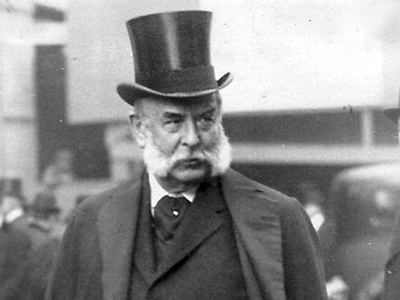
In 1854 No. 13 was rented by the American banker Junius Spencer Morgan, who bought the house in 1858. On his death in 1890 his son, John Pierpoint Morgan, inherited the house. Pierpoint Morgan spent up to three months every year in London, either in Princes Gate or at Dover House, Putney Heath. He was a collector of great art, paintings, books, and many other objects, most of which were kept at Princes Gate. By 1900 the collection was too big to be contained in the house and part of it was loaned to the Victoria and Albert Museum. His collection of paintings included works by Reynolds, Gainsborough, Romney, Constable, Van Dyke, Rembrandt, Franz Hals, Velázquez and Holbein. For the nine months of the year that Pierpoint Morgan was away from London, the house was cared for by his housekeeper. In 1904, he bought the house next door, No. 14, from Schenley’s widow, Mary, and amalgamated it with No. 13. The conjoined house was numbered 14. Its external appearance remained that of two separate houses, but internally structural alterations were made. These included the replacement of No. 14′s principal staircase by an octagonal hall, and the creation of a lobby with marble columns on the floor above. Pierpoint Morgan died in 1913 and the house was inherited by his son, John Pierpoint Morgan junior. The latter never lived in the house and in the First World War he loaned it to the Council of War Relief for the Professional Classes, who used it as a maternity home.
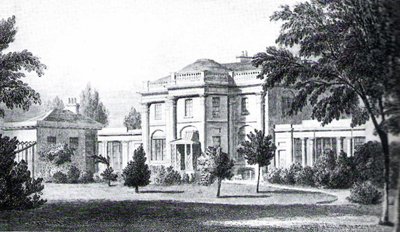
After the war the house was offered to the American Government as a home for their ambassadors and this offer was accepted in 1921. The house was first used for this purpose in 1929, and this use continued with one interval until 1955. Official business was not conducted at the house, but at the Embassy in Grosvenor Square. The American architect Thomas Hastings was employed to refurbish the building and remodel the façade. As part of this, in 1925-26, he added images of the heads of Native Americans in the keystones of the arches over the ground floor windows. Hastings transformed the façade producing a rare and important example in this country of American Beaux-Arts classicism (see below). On the interior he added a grand staircase and modified rooms on the lower two floors to make them more suitable for entertaining.
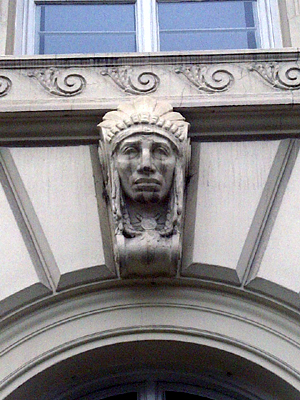
Eight ambassadors lived in the house. The first of these was Charles Gates Dawes, who lived there from 1929 to 1932. The Dawes Plan was named after him and he was awarded the Nobel Peace Prize. Before he moved to London he was Vice President of the United States. He was succeeded for a short time in 1932 by the banker Andrew Mellon. Like John Pierpoint Morgan, Mellon was a major art collector and for a time his collection was housed at Princes Gate. Mellon was followed by Robert Worth Bingham who served until 1937; he was the ambassador who had the longest residence in the house.
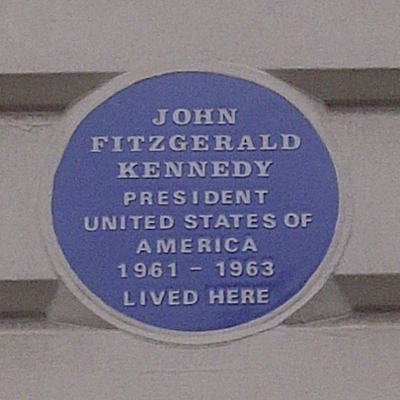
Next came Joseph Kennedy, father of the future President of the United States, John F. Kennedy who stayed at the premises as a young boy in the late 1930s. During the Second World War, the ambassador was John Winant, although he did not live in the house, which remained vacant throughout the war. Winant resigned in 1946 and the following year was succeeded by Lewis Douglas, who lived in the house until 1950. The next ambassador was Walter Gifford who served until 1953 when he was succeeded by Winthrop Aldrich. Gifford kept a low profile, though when he was recalled by Eisenhower, Winston Churchill complained “What are you doing removing one of the best ambassadors we have ever had?” By 1955 a large block of flats had been built next to the house that overlooked and dominated its terrace and the garden behind it. This was considered to be a security risk so the house was sold and the American ambassadors lived elsewhere.
The house was bought by the Independent Television Authority in July 1955 who used it as their headquarters for six years. They moved out in 1961 when it had become too small for their needs and the house was empty for a year. In July 1962 the Royal College of General Practitioners bought the freehold of the house for £175,000 to develop it into their headquarters. In 1976 the business of the College was extended next door into No. 15 Princes Gate. In 1992 the College obtained the freehold of No. 15. The College sold the building in 2010.
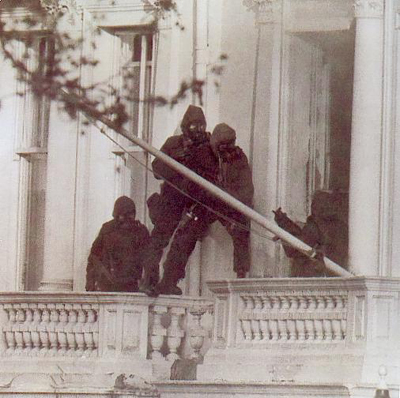
The work of the College was disrupted on the morning of 30th April 1980 with the onset of the Iranian Embassy Siege. The Iranian Embassy was sited next to the College at No. 16 Princes Gate. The College was evacuated, except for two administrators who were retired naval officers. In all, the siege lasted for five days and seven people were killed. The College was evacuated and the Special Air Service used it as a base to plan their operations, drilling holes in the walls to observe the terrorists’ movements. Eventually, when a hostage had been killed on the fifth day, the SAS stormed the building, abseiling from the roof, bursting through a wall and, famously, entering through the front windows of the Embassy.
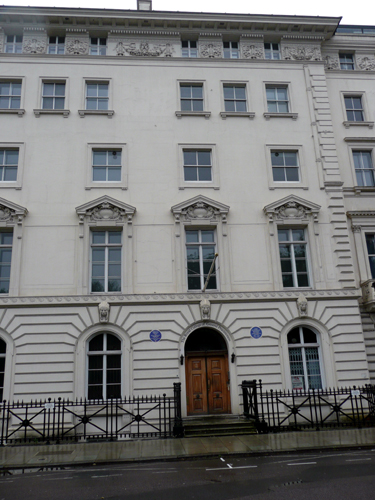
Architecture
Like the buildings at the other end, Nos. 13 and 14 are slightly set forward from the rest of the terrace. All the houses in the terrace have five storeys and a basement, and all are stuccoed. As first built, Nos. 13 and 14 were similar houses. Like the rest of the terrace, each had a projecting porch with Ionic columns. To the left of these were two windows. The first floor had a balustraded balcony and three windows over which was a cornice with a central pediment (as survives on No. 15 – see below). This was changed by Hastings’ remodelling of the façade in 1925-26. The house as a whole now has four bays with rusticated quoins on both corners. On the ground floor, from the east there are two round-headed windows, then the entrance door with a round arch, and then another round-headed window. The keystone of each of these arches bears the image of a Native American. All the other windows in the building are square-headed. The porches and first-floor balconies were removed in Hastings’ remodelling of 1925-26. The first floor has four windows; over each of these is a pediment containing decorative plasterwork. The second floor has four windows, while the third floor has six windows. The top floor also has six windows, with decorative plasterwork between them, and over these is a cornice.
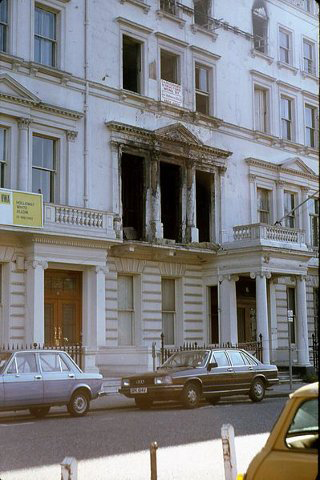
Until 2010, the building continued to be used as the administrative headquarters of the Royal College of General Practitioners. As such, it included offices, a library, a museum, rooms for meetings and conferences, and residential accommodation for officers and members of the College. Behind the building is an enclosed garden, formed by the terrace in Prince’s Gate and other terraces, in a similar fashion to other London squares.
The Buildings are listed Grade II.
I was asked to carry out an analysis of the paint on the front and rear elevations.
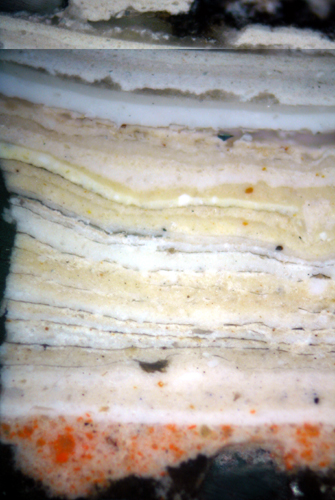
Credits
This has been taken from several sources:
a) Huge amounts from Wikipedia;
b) British History Online: ‘Princes Gate and Ennismore Gardens: The Kingston House Estate: Kingston House and the Kingston House Estate’, Survey of London: volume 45: Knightsbridge (2000), pp. 157-160., and
c) John Horder and Stephen Pasmore. 14 Prince’s Gate: Home of the Royal College of General Practitioners. Exeter: Royal College of General Practitioners. 1987.
Notes
1 Throughout this essay I have retained the original numbering system. Strictly speaking there has not been a No. 13 since it was combined with the next door No. 14 in 1925-26.
2 It was interesting to see that John Elger and John (later Sir John) Kelk were working on these buildings at Princes Gate at the same time as they were working at No. 18 St James’s Square another of my projects.
View Larger Map


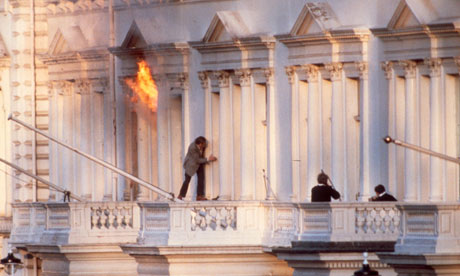
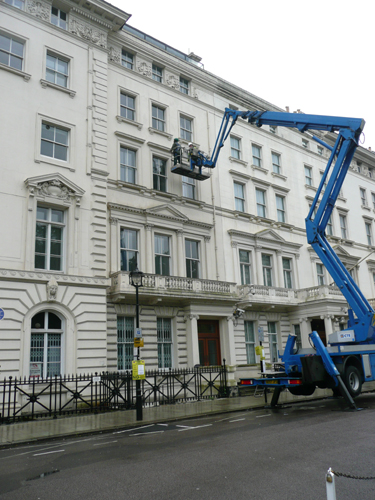










No comments yet. Be the first!